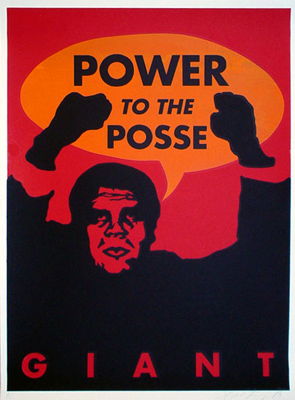
|
The Social Lives of Shepard Fairey's Street Art: Page 2 |
| The materialization of "Andre" and OBEY can be different depending upon where the image is located and what presentation form the image takes. An important aspect of both these images to consider is that any representation of either image is only a reproduction of the image. Considering this, Walter Benjamin's The Work of Art in the Age of Mechanical Reproduction, can help to explain Shepard's unique form of street art. In it, Benjamin says, "Mechanical reproduction of art changes the reaction of the masses toward art" (Benjamin 234). Because of the viral nature of Fairey's street art, the way that he reproduces his images potentially has an effect upon those who view them. Benjamin also spoke of an image's presence in space and time, saying, "Even the most perfect reproduction of a work of art is lacking in one element: its presence in time and space, its unique existence at the place where it happens to be" (Benjamin 220). Fairey's street art seems to defy the logic of the preceding statement by his intention to reproduce mass amounts of the image and, "Fairey understands that the loss of visual information which accompanies reproduction (particularly when you Xerox a photograph) can transform the particular into the iconic" (McCormick 53). Not only did Fairey intend for the images to be widely reproduced and disseminated, but he also intended for them to transcend the particular and become iconic. |
 |
 |
But perhaps the most important of the three key tenets for Fairey's "Andre" and OBEY is mobility. This is where Shirvanee's term locative media comes into play and where the social lives of these two images are played out. Both of these images are pieces of street art that once placed on a surface, do not move from the surface until either taken down by force or due to their slow erosion. So, how could the visual objects develop their own social lives without the possibility for recontextualization? Rose defines recontextualization as the process whereby a visual object, "In its social life and travels...passes through different cultural contexts which may modify or even transform what it means" (Rose 223). What is not included in this definition is the multitude of different people with whom a stable image on a city wall has the ability to affect and be affected by every day. Referring back to Shirvanee's locative media, it is apparent that an image need not actually move in order to affect some sort of change, or to change itself. One can refer to Kevin Lynch's idea, from his book What Time is This Place?, that environmental change and social change have a 'loosely coupled, bi-directional relation' with each other. Thus, the way that an image is recontextualized is not necessarily through changing the environment, but through effecting some sort of societal change that has the ability to affect the way that said environment is perceived, thus constructing an immobile image's social life. |
| It is because his desire for his images to be as widespread as possible that "Andre" and OBEY have become iconic. The viral phenomena of each their processes of dissemination has created them as particular pieces of locative media, whose location on the street not only affects the way that people view them, but due to this social change, it also creates a social life for them while they remain inmovable. |
| Anthropological Approach see: [The Social Life of Obama Hope].
[Home]
[Foucauldian Discourse Analysis]
[The Social Lives of Images]
|